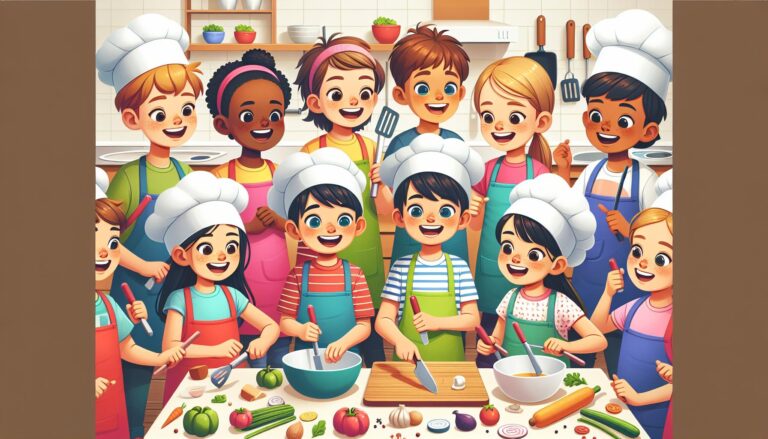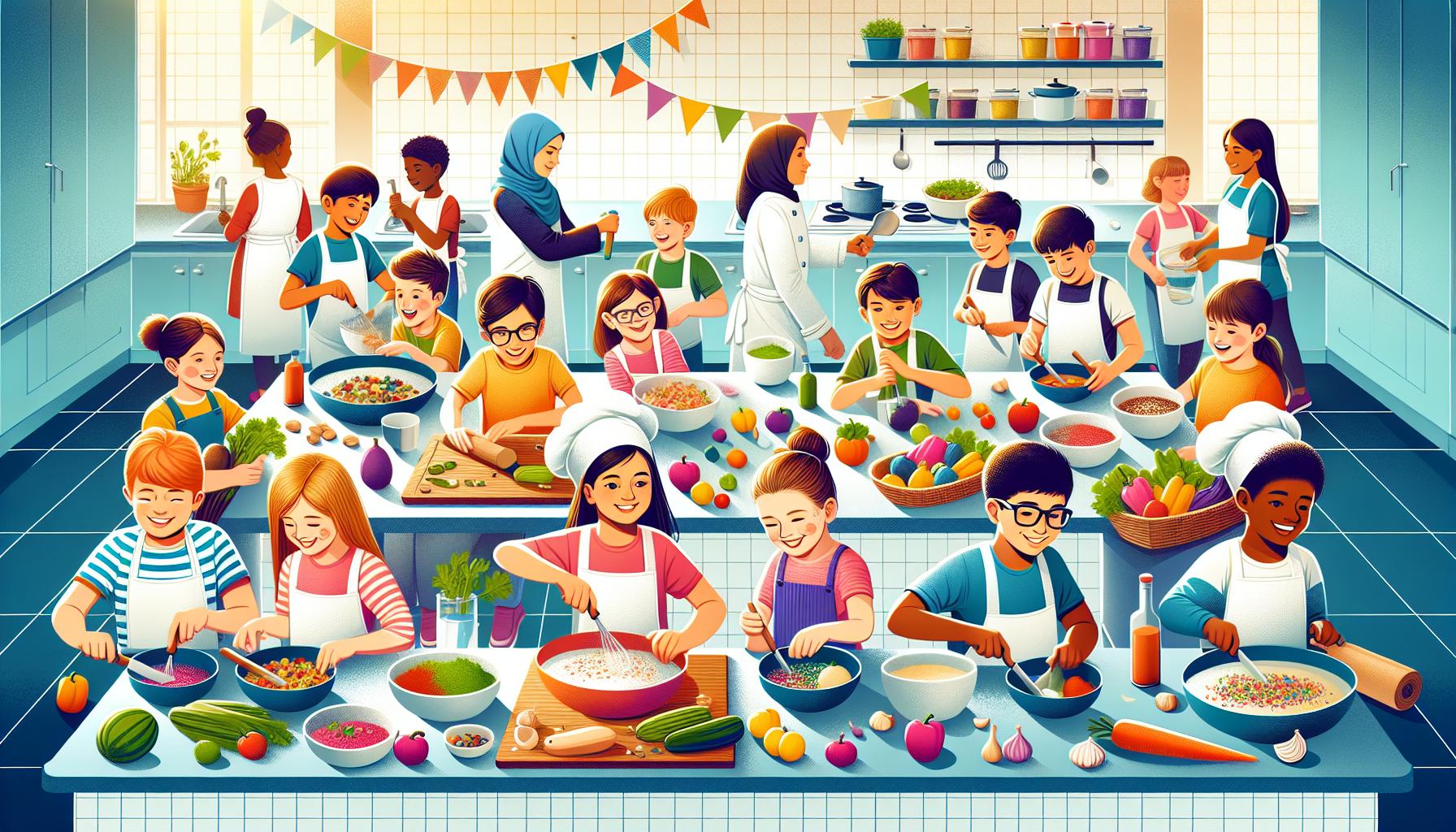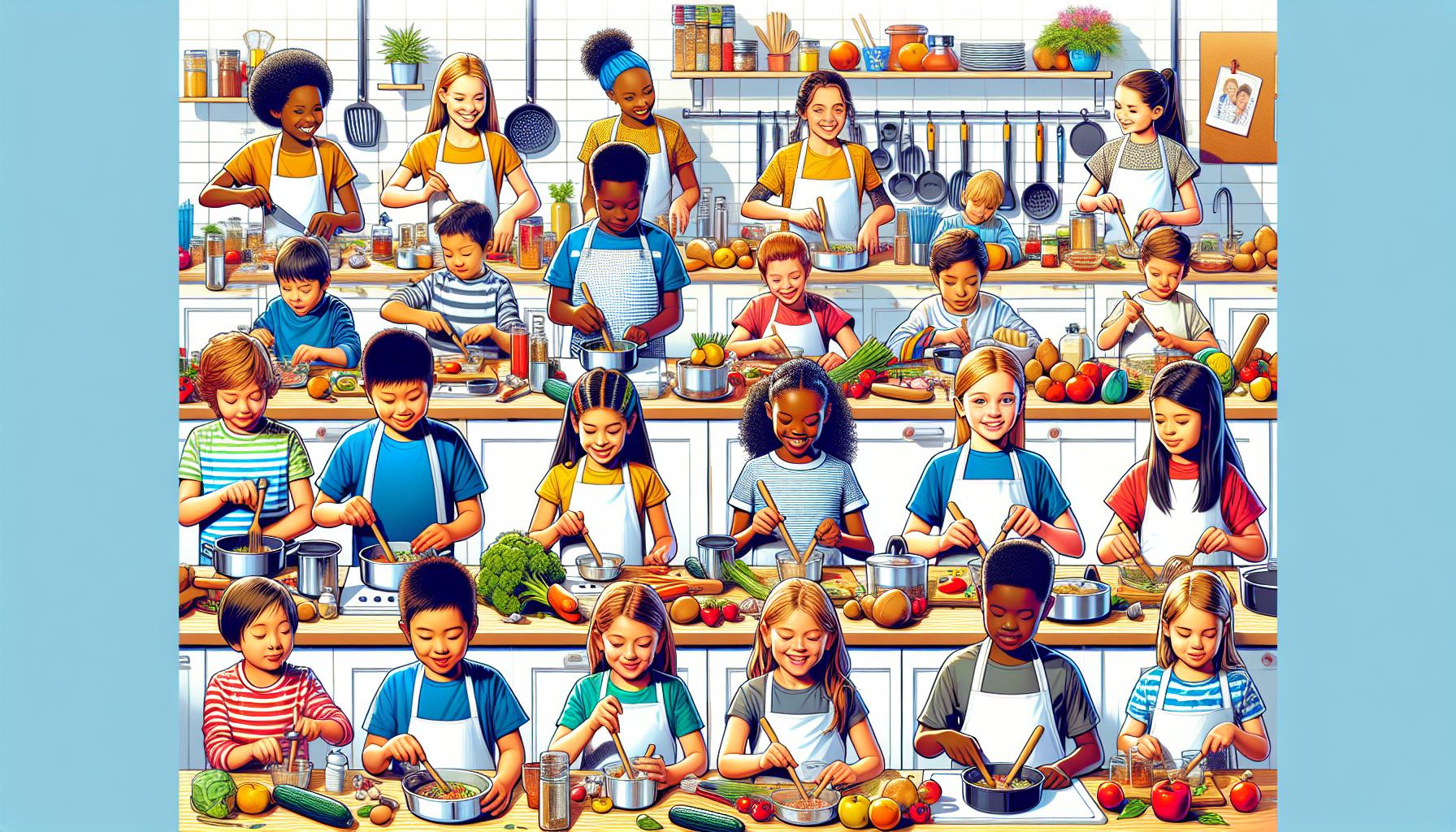
Watching kids discover the magic of cooking brings joy to every parent’s heart. We understand you’re looking for fun and educational cooking classes that’ll spark creativity in your little ones while teaching them valuable life skills.
Looking for the perfect cooking class for your child doesn’t have to be overwhelming. We’ve explored local culinary programs designed specifically for young chefs and found amazing opportunities that combine learning with entertainment. What cooking skills would your child love to master? From basic kitchen safety to creating their own recipes kids can develop confidence and independence through hands-on cooking experiences.
Key Takeaways
- Local cooking classes for kids offer valuable life skills development through hands-on culinary experiences, including math concepts, reading comprehension, and critical thinking
- Programs are typically available in three formats: after-school classes (60-90 minutes), weekend workshops (2-4 hours), and summer camps (full/half-day programs)
- Quality cooking schools group children by age ranges (5-7, 8-11, 12-15) and maintain strict safety measures with student-to-teacher ratios of 6:1 or less
- Classes are available through community centers ($75-150 per course) and culinary schools ($200-350 for programs), with various payment plans and scheduling options
- Essential preparation includes proper safety equipment (apron, closed-toe shoes) and following basic kitchen safety guidelines
- Parents should consider additional costs like take-home materials ($15-50) and plan for registration deadlines 1-2 weeks before classes begin
Benefits of Cooking Classes for Children
Cooking classes offer children valuable skills beyond food preparation. These interactive sessions create a foundation for lifelong learning through hands-on culinary experiences.
Life Skills Development
Cooking classes teach children essential mathematical concepts through measuring ingredients, timing recipes and calculating serving sizes. Kids learn organizational skills by gathering ingredients, following step-by-step instructions and cleaning their workstations. The classes reinforce reading comprehension as students interpret recipes, nutrition labels and cooking instructions. Kids develop critical thinking by:
- Making ingredient substitutions
- Adjusting recipes for different serving sizes
- Planning meal preparation sequences
- Problem-solving when recipes don’t go as planned
- Understanding kitchen safety protocols
Building Confidence in the Kitchen
Children gain independence through mastering basic cooking techniques like:
- Mixing and measuring ingredients
- Using age-appropriate kitchen tools
- Following food safety guidelines
- Creating simple recipes from start to finish
- Plating and presenting their dishes
The supportive environment allows kids to experiment with new ingredients and cooking methods. Each successful dish boosts their self-esteem and motivates them to try more complex recipes. Small group settings give children opportunities to:
- Share ideas with peers
- Practice teamwork in meal preparation
- Receive individual attention from instructors
- Celebrate their culinary achievements
- Express creativity through food presentation
These skills translate into increased confidence in other areas of their lives as they master new abilities and overcome challenges in the kitchen.
Types of Kids’ Cooking Programs

Local culinary schools offer diverse cooking programs designed for young chefs ages 5-15. Each program type accommodates different schedules while maintaining a focus on age-appropriate kitchen skills development.
After-School Classes
After-school cooking programs run on weekdays between 3 PM and 6 PM, offering flexible scheduling for busy families. These 60-90 minute sessions focus on fundamental cooking techniques like measuring ingredients, mixing methods, and kitchen safety. Children practice making simple recipes, such as homemade pasta, fresh salads, and baked treats. Class sizes typically range from 8-12 students, allowing instructors to provide individual attention.
Weekend Workshops
Weekend workshops provide immersive 2-4 hour cooking experiences on Saturdays and Sundays. These themed sessions explore specific cuisines or cooking techniques, such as:
- International food exploration (Italian pizza making, Japanese sushi rolling)
- Baking fundamentals (bread making, cookie decorating, cake assembly)
- Farm-to-table cooking with seasonal ingredients
- Holiday-specific meal preparation
- Healthy snack creation
Summer Camps
Summer cooking camps run during school breaks, offering full-day or half-day programs for 1-4 weeks. These comprehensive programs include:
- Daily hands-on cooking activities
- Kitchen science experiments
- Food art projects
- Basic nutrition education
- Garden-to-table experiences
- Team cooking challenges
- Recipe development skills
- Food photography basics
Each camp session accommodates 15-20 children, grouped by age ranges (5-8, 9-12, 13-15) to maintain appropriate skill levels. Participants complete the program with a recipe collection and basic knife skills certificate.
What to Look for in a Local Cooking School

Finding the right cooking school for kids requires attention to specific features that create a safe, engaging learning environment. These key elements differentiate excellent programs from basic classes.
Age-Appropriate Curriculum
A quality cooking school groups children by age ranges (5-7, 8-11, 12-15) to match their skills and learning pace. Each age group receives lessons crafted for their abilities:
- Ages 5-7: Simple no-cook recipes, basic kitchen tool identification, measuring ingredients
- Ages 8-11: Basic knife skills with child-safe tools, stovetop cooking with supervision, recipe reading
- Ages 12-15: Advanced techniques like sautéing, baking science, meal planning
The curriculum progresses through measurable skill levels, allowing kids to build confidence at their own pace. Classes include hands-on practice time with immediate feedback from instructors.
Safety Measures and Supervision
Safety standards form the foundation of reputable cooking schools for children. Top programs incorporate these essential elements:
- Student-to-teacher ratios of 6:1 or less for close monitoring
- Child-appropriate equipment (plastic knives for beginners, rounded scissors)
- Clear safety protocols posted in visible locations
- Regular equipment inspections and maintenance
- First-aid certified instructors present at all times
- Proper food handling certification for staff
- Allergen awareness protocols with ingredient lists
- Emergency procedures posted and practiced regularly
Each class begins with safety reminders and equipment demonstrations. Instructors maintain constant supervision during high-risk activities like using heat or sharp tools.
Top-Rated Kids’ Cooking Classes in Your Area
Finding local cooking classes for kids introduces young chefs to culinary skills through hands-on learning experiences. Here’s where you’ll find quality cooking programs near you.
Local Community Centers
Community centers offer affordable cooking classes taught by experienced instructors in well-equipped facilities. Many centers feature 6-week programs that meet once per week for 90 minutes, with small class sizes of 8-12 students. Popular courses include:
- Beginner’s Kitchen Skills: Basic knife techniques, kitchen safety, measuring ingredients
- International Cuisine Adventures: Mexican, Italian, Asian cooking fundamentals
- Healthy Snack Making: Nutritious after-school treats, smoothies, trail mixes
- Holiday Baking: Seasonal cookies, cupcakes, breads
- Farm-to-Table: Using local, seasonal ingredients in simple recipes
Registration fees range from $75-150 per course, with sibling discounts available. Most centers provide all ingredients, equipment and take-home recipe cards.
Culinary Schools
Professional culinary schools deliver structured kids’ programs with industry-standard equipment and certified chef instructors. Classes typically include:
- Junior Chef Academy: 8-week foundational cooking course ($200-300)
- Weekend Workshops: 3-hour themed sessions on pastry, bread, pasta ($65-85)
- School Break Camps: 5-day immersive programs with daily projects ($275-350)
- Parent-Child Classes: Monthly 2-hour sessions for families ($90-120 per pair)
Key features of culinary school programs:
- 6:1 student-to-instructor ratio
- Individual cooking stations
- Take-home chef’s apron and recipe book
- Final showcase meal for parents
- Achievement certificates upon completion
Many schools offer skill level assessments to place children in appropriate classes based on experience rather than age alone.
Preparing Your Child for Cooking Class
Setting your child up for success in cooking class starts with proper preparation. Here’s what you’ll need to get started.
Required Materials and Equipment
A well-prepared young chef needs specific items for a productive cooking class:
- A clean apron that fits properly
- Closed-toe, non-slip shoes
- Hair ties or clips for long hair
- A reusable water bottle
- Food storage containers for taking creations home
- A notebook and pen for recipe notes
- Hand sanitizer and cleaning wipes
- Any required ingredients listed by the instructor
Safety Guidelines
Kitchen safety forms the foundation of every successful cooking class experience:
- Wash hands with soap for 20 seconds before handling food
- Keep fingernails trimmed and clean
- Remove jewelry before class
- Roll up long sleeves
- Listen carefully to instructor directions
- Hold knives properly with the blade pointing down
- Use potholders or oven mitts for hot items
- Clean spills immediately
- Report accidents to the instructor
Equipment Safety Rules:
- Only use appliances under supervision
- Keep electrical cords away from water
- Turn pot handles inward on stovetops
- Use step stools safely for reaching items
- Ask for help with sharp tools
These preparation steps create a safe learning environment where children gain confidence in their cooking abilities. Each guideline reinforces responsible kitchen habits that transfer to cooking at home.
Cost and Schedule Considerations
Program Fees and Payment Options
Kids’ cooking classes range from $15 to $45 per session for group classes. Multi-class packages offer savings of 10-20% compared to individual sessions. Weekly classes typically cost $120-200 for 4-week programs while holiday camps run $250-400 for 5-day sessions.
| Program Type | Duration | Cost Range |
|---|---|---|
| Single Class | 2 hours | $15-45 |
| Weekly Program | 4 weeks | $120-200 |
| Holiday Camp | 5 days | $250-400 |
| Parent-Child Class | 2.5 hours | $65-85 |
Many cooking schools offer flexible payment plans including:
- Monthly installments for long-term programs
- Early bird discounts (15-25% off) for advance registration
- Sibling discounts of 10% per additional child
- Scholarships for eligible families
Class Scheduling Options
Cooking classes accommodate various schedules with multiple time slots:
- After-school sessions (3:30 PM – 5:30 PM)
- Weekend morning classes (9:00 AM – 11:00 AM)
- Weekend afternoon classes (2:00 PM – 4:00 PM)
- School holiday programs (9:00 AM – 3:00 PM)
Registration deadlines fall 1-2 weeks before class start dates. Makeup classes remain available within 30 days for missed sessions. Class sizes stay limited to 8-12 students, so early registration helps secure preferred time slots.
Additional Expenses
Parents can plan for these extra costs:
- Aprons and chef hats ($15-25)
- Take-home recipe books ($10-20)
- Food storage containers ($5-15)
- Special ingredients for specific classes ($10-30)
- Optional cooking tool sets ($30-50)
Pro tip: Many programs include basic supplies in their registration fees. Ask about included materials before purchasing additional items.
Conclusion
Watching our children discover the joys of cooking is truly rewarding. With so many local cooking classes available kids can embark on culinary adventures that’ll shape their future relationship with food. These programs offer much more than just cooking skills – they’re gateways to confidence building mathematical learning and creative expression.
We encourage parents to take that first step in finding the perfect cooking class for their young chefs. The investment in our children’s culinary education will yield delicious results and lifelong skills they’ll cherish. Let’s empower the next generation of home cooks one recipe at a time!
Frequently Asked Questions
What age groups can participate in kids’ cooking classes?
Most cooking classes cater to children aged 5-15, typically divided into three age groups: 5-7, 8-11, and 12-15. Each group receives age-appropriate instruction and curriculum designed to match their skill level and learning pace.
How much do kids’ cooking classes typically cost?
Individual group classes range from $15-45 per session, while weekly programs cost $120-200. Holiday camps are priced between $250-400. Many programs offer discounts for early registration, siblings, and multi-class packages, with some providing scholarship opportunities.
What safety measures are in place during cooking classes?
Classes maintain low student-to-teacher ratios and employ first-aid certified instructors. They use child-appropriate equipment, enforce strict safety guidelines, and provide proper supervision. Children learn proper handwashing techniques and equipment handling procedures.
What should children bring to cooking classes?
Essential items include a clean apron, closed-toe shoes, hair ties, reusable water bottle, food storage containers, and a notebook. Some classes may require specific ingredients, but most supplies are typically included in the registration fee.
What types of programs are available?
Programs include after-school classes focusing on basic techniques, weekend workshops exploring specific cuisines, and summer camps offering comprehensive cooking experiences. Community centers and professional culinary schools provide various options like beginner kitchen skills, international cuisines, and holiday baking.
How do cooking classes benefit children?
Cooking classes teach essential life skills including math through measuring, organizational skills through following recipes, and critical thinking through ingredient substitutions. They also build confidence, independence, and teamwork skills while fostering creativity in a supportive environment.
Are there flexible scheduling options available?
Yes, programs offer various scheduling options including after-school sessions, weekend classes, and school holiday programs. Classes are designed to accommodate different schedules and skill levels, with limited class sizes to ensure personal attention.
How are children grouped in cooking classes?
Children are grouped by age ranges to ensure appropriate skill development and learning pace. This grouping allows instructors to tailor lessons and activities to each age group’s capabilities and interests.

